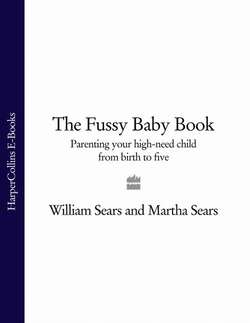Читать книгу The Fussy Baby Book: Parenting your high-need child from birth to five - Martha Sears - Страница 35
first-class baby
ОглавлениеA lot of this book was written in the peace and quiet of coast-to-coast flights during a year of frequent public speaking. On one flight, when I was fortunate to be upgraded to first class, I identified with a high-need baby who “has it made”. He gets a higher standard of care – he goes first class! The high-need baby gets held more because he protests if he is put down. The high-need baby gets fed more because he demands it. He (usually) enjoys the first-class comfort of sleeping with his parents because he refuses to sleep separate. And, he gets taken to more interesting places because he is unwilling to accept a lower level of care. For high-need babies, life is one continuous upgrade.
“Schedule” is not in the high-need baby’s vocabulary. Early on, these smart infants learn that the breast or bottle is not only a source of nutrition, but also a source of comfort. In fact, research has shown that non-nutritive sucking (sucking for comfort rather than for food) is one of the earliest ways a baby learns to settle. Mothers figure this out quickly and, unfortunately, many of them get their babies hooked on dummies so they can be put down, away from mother, a lot. We prefer that mother use her own finger to give baby extra suck time if he is bottle-fed, or if she knows he doesn’t need any more milk from her breast, or if her breasts need a break.
A recurrent theme that we hear from the parents of high-need babies is “She wants to feed all the time.” Martha’s experience with Hayden is a perfect example. Because our first three babies went an average of three hours between feedings – or even four hours once we added solid food to their diet in the early months – she expected the same from Hayden. Her approach with the first three was to feed them when they cried. But when Hayden cried one hour after being fed, she wondered what to do. Of course, feeding is what Hayden needed, Martha discovered. Yet how could this be? She spent two weeks charting Hayden’s feeding habits in an effort to see what sort of schedule she had. At the end of the two weeks she looked at the chart and concluded that this baby simply didn’t have a schedule. That’s when Martha adopted the slogan “go with the flow”.
Expect baby’s need to nurse to intensify during high-need days when baby will naturally gravitate toward her favourite pacifier and person, which to a breast-fed baby is one and the same. Yes, you will feel like a human dummy or “pacifier”, because you are. Yet, consider that “pacifier” means “peacemaker”. Certainly this is the ultimate goal of parenting the high-need baby: to give this growing infant an internal peace during those tumultuous months after birth, when baby is learning to settle into life; this will help her learn to create inner peace on her own.
Nursing is a wonderful time-out when we are both wearing thin. It alleviates a tightened clash of the wills and provides a calm and loving oasis where we are both refreshed. I am always grateful for prolactin [the breast milk-producing hormone that has a relaxing effect on mother].
Not only do high-need babies breast-feed more frequently, the need for breast-feeding lasts longer. These babies are notoriously slow to wean. They realize that they have a good thing going and that it would be foolish to give it up quickly. It is not unusual for high-need babies (unless forced to wean before their time) to breast-feed at least two years. (See weaning, pages 150–1, for how extended feeding benefits mother and child.)
